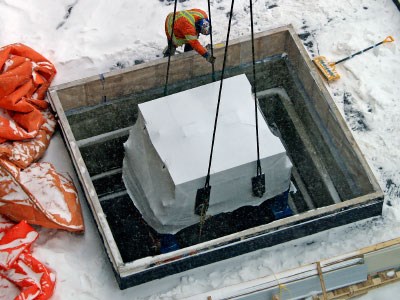There are unique construction projects, and then there is the cyclotron in Thunder Bay — one of a very few across Canada, and the only one in Northern Ontario. This particle accelerator is used to create radioisotopes for nuclear imaging, used in both patient care and research. Yes, that’s “nuclear” as in “radioactive,” and that took construction in a whole new direction.
“There were a lot of challenges with the project,” said Parker Jones, operations manager for Tom Jones Corporation, the general contractor on the project. “It was highly specialized work.”
That’s an understatement. The cyclotron is housed in the new seven-storey Health Services building, part of the Thunder Bay Regional Health Sciences Centre complex.
One challenge from the start was the fact that the Canadian Nuclear Safety Commission had final sign-off on the radiopharmacy and cyclotron facility design.
Construction on the building actually started before that process was completed. The basement of the building was designed to allow for the installation of the radiopharmacy and the cyclotron bunker later in the build.
Constructing the bunker itself required carefully calculated placement of concrete, steel, and lead lining to ensure no radioactive particles escape the bunker, and that all workers were safe from exposure.
There is no danger of a “meltdown” as with a nuclear reactor. A power outage, for example, would simply stop the machine from producing isotopes. However, like all radioactive-generating machines, the system has to be properly contained to stop radioactive particles from escaping during operation.
The cyclotron itself is housed in an enclosed room plugged by a 15-ton concrete door 2.5-metres thick, and mounted on rails to support the weight. This door is stepped like a three-layered pyramid, creating right angles to ensure no gamma rays or other particles — which only travel in straight lines — can slip out between the cracks.
The radioactive material produced by the cyclotron travels down lead-lined trenches to special radiopharmacy units that safely contain and prepare the radioisotopes. These systems were installed, assembled, and calibrated by a specialized team from Italy.
Tom Jones was responsible for the physical building and interior fit-up. In fact, it took the expertise of many different trades from Thunder Bay and abroad to bring the whole project together.
“We’re grateful for the opportunity to bid on the work and execute it,” Jones said. “We’re glad we had a lot of good local sub-trades who all came together, and it was delivered on time.”
Timing was more exacting than with most projects since delivery of this highly sensitive equipment had to be done carefully.
The 28-ton cyclotron was lowered into the bunker on Feb.10, through a hole at the base of the Health Services building. The hole was then sealed with another three-layered pyramid slab of concrete.
“We are familiar with bunker construction, and we have built and worked in numerous bunkers in the past,” Jones said. This, however, was the most complex bunker construction by far.
The building project was a feat in itself, but it represents an even bigger accomplishment for the community and region. With the Chalk River nuclear reactor scheduled to shut down in 2018, Thunder Bay’s cyclotron will supply its own radioisotopes for all regional patients.
In fact, it will be a much more secure supply, since previous shipments could be lost to natural radioactive decay due to weather or other delays.
The decision was made to purchase a cyclotron that could make several different types of isotopes, including fludeoxyglucose (FDG) and technetium-99m. It may even become the supplier for other parts of Ontario and perhaps beyond.
Also important, it will ensure that scientists at the Thunder Bay Regional Research Institute (TBRRI) will have a supply of radioisotopes.
The cyclotron has already opened up new research possibilities, plans for clinical trials, and partnerships with other research institutes around the world that otherwise would not be possible.
“We’re very happy with how this project came together,” Jones said. “This was a great project for us, for the hospital, and for the community. They’re going to get better health care because of the project. That’s the idea.”




